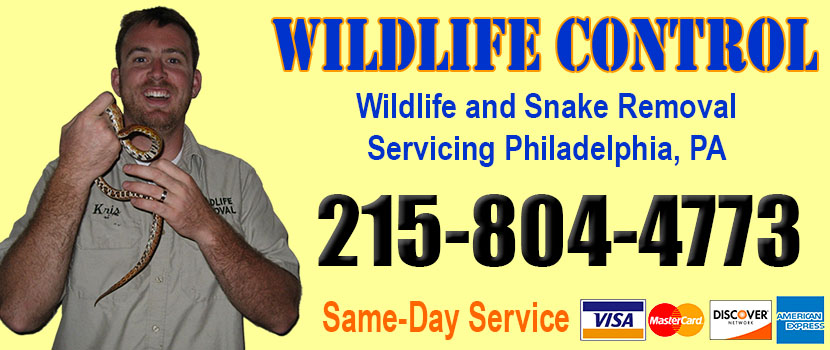
Welcome to philadelphiasnakes.com! I am David, a snake enthusiast living in Philadelphia, PA. Many people don't know that Philadelphia is in fact full of snakes! You just need to know where to find them - they can often be shy and elusive. Some Pennsylvania snake species are more common outside of the city limits, in different parts of Montgomery County PA, but many types of snakes are indeed common in the more urban parts of Philadelphia. This guide is meant to help educate you about the beautiful snakes of Philadelphia, and to help you identify the most common snakes of Philadelphia, as well as the venomous snakes of Philadelphia that you should learn to recognize and avoid. If you want more detail, click here for my complete list of ALL snake species in Philadelphia. Remember the following:
- Most snakes of Philadelphia are harmless and don't want to encounter you
- Venomous snakes exist but are uncommon in Philadelphia, Pennsylvania
- Snakes eat rats and mice and are a valuable part of the Pennsylvania ecosystem
- Never kill a snake - if you leave a snake alone, it will leave you alone.
Common Snake Species in Philadelphia
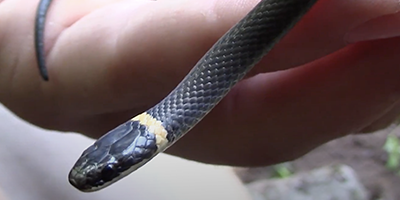 Northern Ring-necked Snake:
This is a small snake with distinctive features that are easy to identify. A northern ring-necked snake is a non-venomous snake with an average length of 12 to 15 inches. Despite being harmless, these snakes appear harmful mainly because their upper body is olive-brown to dark gray.
When this snake raises its head above the ground, you might also get to see the yellow or bright orange ring pattern around its neck.
Northern Ring-necked Snake:
This is a small snake with distinctive features that are easy to identify. A northern ring-necked snake is a non-venomous snake with an average length of 12 to 15 inches. Despite being harmless, these snakes appear harmful mainly because their upper body is olive-brown to dark gray.
When this snake raises its head above the ground, you might also get to see the yellow or bright orange ring pattern around its neck.
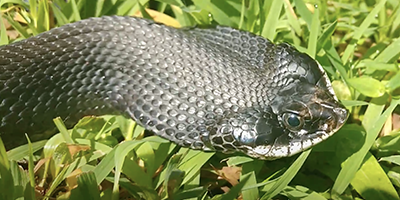 Eastern Hog-nosed Snake:
Here is another non-venomous snake found in Philadelphia. Eastern hog-nosed snakes always try to mimic the deadly cobra by spreading the skin around its head and neck region, while rolling back and forth opening its mouth. With this, it can fend off prey.
This eastern hog-nosed is a long snake that can grow as long as 33 inches in the wild. Just as its name implies, it has a pointed upturned nose covered in scales. The upper body of this snake is dark brown to gray with brown blotches.
Eastern Hog-nosed Snake:
Here is another non-venomous snake found in Philadelphia. Eastern hog-nosed snakes always try to mimic the deadly cobra by spreading the skin around its head and neck region, while rolling back and forth opening its mouth. With this, it can fend off prey.
This eastern hog-nosed is a long snake that can grow as long as 33 inches in the wild. Just as its name implies, it has a pointed upturned nose covered in scales. The upper body of this snake is dark brown to gray with brown blotches.
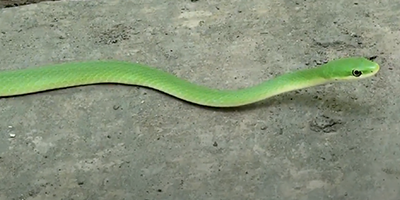 Northern Rough Green Snake:
This particular species of snake is common in areas with plenty of trees in Pennsylvania. They are good climbers and can hardly be found on the ground crawling. An adult northern rough green snake is between 22 to 32 inches long. With their long and slender body alongside their large eyes, they can climb trees of any height.
The upper body of a northern rough green snake is usually light green, while the belly can either be yellowish-green or cream-colored.
Northern Rough Green Snake:
This particular species of snake is common in areas with plenty of trees in Pennsylvania. They are good climbers and can hardly be found on the ground crawling. An adult northern rough green snake is between 22 to 32 inches long. With their long and slender body alongside their large eyes, they can climb trees of any height.
The upper body of a northern rough green snake is usually light green, while the belly can either be yellowish-green or cream-colored.
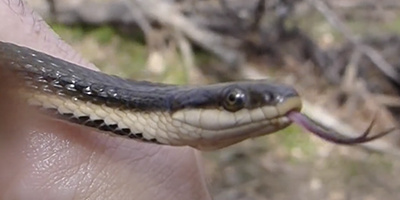 Queensnake:
This species of snake is not just common in Pennsylvania, but also commonly seen around the banks of ponds, lakes, streams, and rivers. An adult queensnake can be as long as 23 inches. Unlike other snakes, it is very easy to identify. This snake has a tan to greenish upper part with a yellow stripe on the lower side.
Queensnake:
This species of snake is not just common in Pennsylvania, but also commonly seen around the banks of ponds, lakes, streams, and rivers. An adult queensnake can be as long as 23 inches. Unlike other snakes, it is very easy to identify. This snake has a tan to greenish upper part with a yellow stripe on the lower side. Venomous Snake Species in Philadelphia
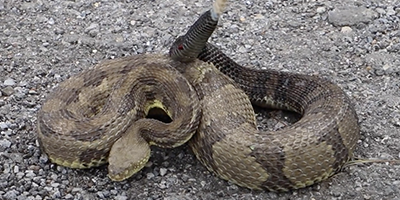 Timber Rattlesnake:
This snake is the most encountered venomous snake in Pennsylvania. With a length of 35 to 60 inches, this species of snake can be found in crevices, near rock outcroppings, and ledges in upland forests. These snakes have two different distinctive color patterns, the yellow and the black phase skin. Each of these skin color phases has V-shaped blotches and bands on the upper part of its skin. Also, the tail is black to solid brown and the head is triangular, large, and flat.
Timber Rattlesnake:
This snake is the most encountered venomous snake in Pennsylvania. With a length of 35 to 60 inches, this species of snake can be found in crevices, near rock outcroppings, and ledges in upland forests. These snakes have two different distinctive color patterns, the yellow and the black phase skin. Each of these skin color phases has V-shaped blotches and bands on the upper part of its skin. Also, the tail is black to solid brown and the head is triangular, large, and flat. 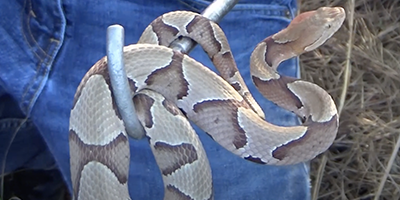 Northern Copperhead:
This is an aggressive venomous snake that you need to stay clear of if you are in Pennsylvania. They are very aggressive and won't hesitate to defend themselves in any way they can. These snakes are usually 24 to 36 inches long with a bright coloration that is always very obvious. These snakes are usually gray-brown to tan in color with red-brown to dark-brown bands along their body. The pupils are elliptical and their head is usually triangular and flat in shape.
Northern Copperhead:
This is an aggressive venomous snake that you need to stay clear of if you are in Pennsylvania. They are very aggressive and won't hesitate to defend themselves in any way they can. These snakes are usually 24 to 36 inches long with a bright coloration that is always very obvious. These snakes are usually gray-brown to tan in color with red-brown to dark-brown bands along their body. The pupils are elliptical and their head is usually triangular and flat in shape.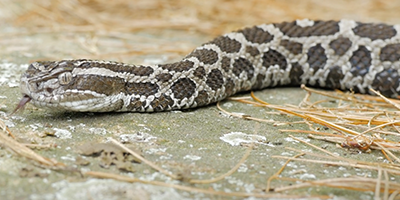 Eastern Massasauga Rattlesnake:
Despite being a venomous snake, they are very docile and won't attack unless they feel threatened. These 40-inch snakes have a thick body and rough scales. Unlike most rattlesnakes, it has nine scales that are large at the top of its head. It has a brownish-gray color with blotches that are round and dark.
Eastern Massasauga Rattlesnake:
Despite being a venomous snake, they are very docile and won't attack unless they feel threatened. These 40-inch snakes have a thick body and rough scales. Unlike most rattlesnakes, it has nine scales that are large at the top of its head. It has a brownish-gray color with blotches that are round and dark.
If you're unsure, you can email me a photo of the snake at info@philadelphiasnakes.com and I will email you back with the snake's species. If you found a snake skin, read my Found a Skin? page, and you can email me a photo of the skin, and I'll identify the snake for you. If you need professional Philadelphia snake removal help, click my Get Help page, or see the below website sponsor I found, who provides that service.
How to Humanely Get Rid of Snakes
Snakes are harmless and beneficial to our ecosystem. However, thousands of snakes are still being killed yearly due to the common misconception about them. Not all snakes are poisonous; some people, especially those who live in an agricultural setting, even encourage the presence of snakes that will help them manage the population of pests. Snakes will eat rats, mice, and other urban pests; therefore, we recommend using the most humane method if you want to get rid of them.
Ways to Get Rid of the Snakes Humanely
When you see a snake on your property, avoid panicking since it will prevent you from thinking rationally and creating the right decision. First, secure your pets and your kids and make sure that they will stay away from the snake. We advise you to call the assistance of a wildlife removal expert since this will be the safest. Additionally, they will only use humane methods to ensure that the snake will not experience any unnecessary pain during the whole process. However, if you think that is not an option for you, here's how you can do it.
How Should I Start?
Start by identifying the snake; with this, you will be able to determine the behavior of this snake. Snakes are cold-blooded, and they will often look for a place that will provide them with warmth, security, and convenient access to their food source. When inspecting all the possible shelter of the snake, you need to be very cautious. Do not stick your hand on places that you can't see. Wear protective gears and use snake tongs or snake hooks when probing some areas. If you happen to encounter a shed snakeskin indoors, the areas that you need to check will change dramatically. Snakes are very capable of hiding in tiny spaces and places that you don't suspect. They can also climb, so you may want to check your attic.
Should I Use Exclusion or Elimination?
We understand how most of you will not have experience in the proper identification of snakes; therefore, it is always better to consult a snake removal expert. They will identify the creature and provide you with recommendations on how to prevent this from happening again. They can also enlighten you about the existing laws that protect these snakes from improper removal and exclusion.
Finally, you should keep your yard clean. Eliminate the possible hiding places of the snakes, such as the piles of debris and clutters. Trim the low-lying branches of the trees and the shrubs. Mow your lawn regularly and keep it ideally short. Snakes will be drawn to the damp and dark areas of our house. Eliminate their access from that area by surrounding the place with a barrier. Treat your rodent infestation if you want to avoid attracting the attention of the snake. Seal all the possible entry points of the snake using the appropriate construction materials. Rubber sealants, expanding foams, and caulks are all equally effective in sealing the cracks and crevices.
Remember, the term is not poisonous snakes of Philadelphia, it's venomous snakes of Philadelphia. Poison is generally something you eat, and venom is injected into you. That said, dangerous snakes are very rare in Philadelphia. The few venomous snakes of Montgomery County are rarely seen. But they are commonly misidentified, so learn about all the snake species of Philadelphia in order to correctly identify them. These snakes are usually also found in the surrounding towns of Norristown, Pottstown, Lansdale, King of Prussia, Ambler, Collegeville, Horsham, Conshohocken, Blue Bell, North Wales, Souderton, Harleysville, Willow Grove, Hatfield, Royersford, Jenkintown, Hatboro, Glenside, Plymouth Meeting, Montgomeryville, Bryn Mawr, Schwenksville, Fort Washington, East Norriton, Skippack, Wyncote, Narberth, Bridgeport, Eagleville, West Norriton, Wynnewood, Pennsburg, Trappe, Audubon, Lafayette Hill, Arcadia University, Gilbertsville, Gladwyne, Green Lane, East Greenville, West Conshohocken, Flourtown, Oreland, Red Hill, Rockledge, Bryn Athyn, Wyndmoor, Pottsgrove, Sanatoga, Dresher, Maple Glen, and the surrounding areas.
Read our article about:
Where Can I Get Free Snake Removal?
philadelphiasnakes.com domain and hosting costs made possible by the generous support of this sponsor:
